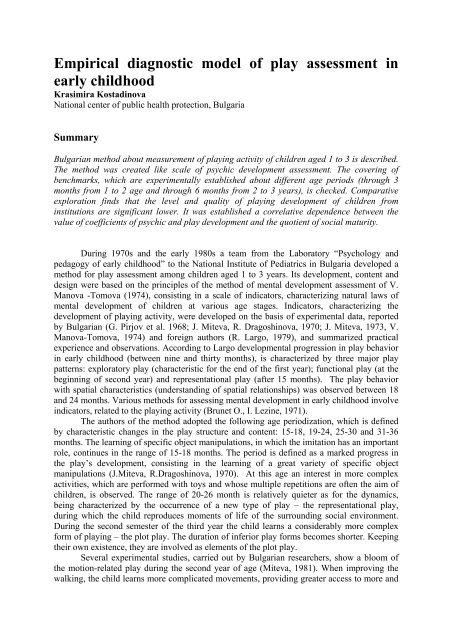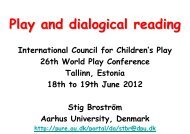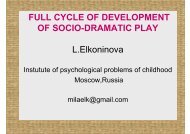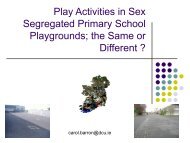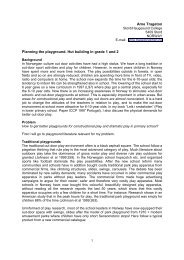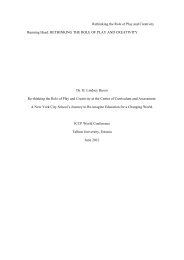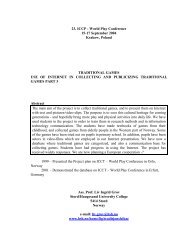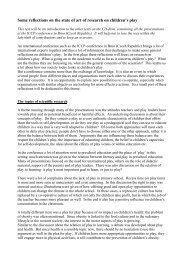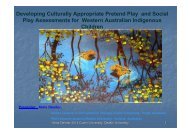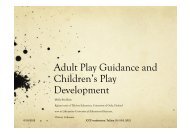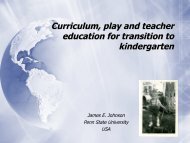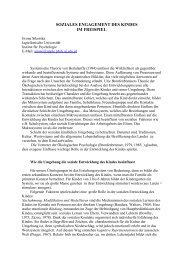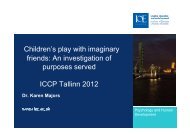Krasimira Kostadinova
Krasimira Kostadinova
Krasimira Kostadinova
You also want an ePaper? Increase the reach of your titles
YUMPU automatically turns print PDFs into web optimized ePapers that Google loves.
Empirical diagnostic model of play assessment in<br />
early childhood<br />
<strong>Krasimira</strong> <strong>Kostadinova</strong><br />
National center of public health protection, Bulgaria<br />
Summary<br />
Bulgarian method about measurement of playing activity of children aged 1 to 3 is described.<br />
The method was created like scale of psychic development assessment. The covering of<br />
benchmarks, which are experimentally established about different age periods (through 3<br />
months from 1 to 2 age and through 6 months from 2 to 3 years), is checked. Comparative<br />
exploration finds that the level and quality of playing development of children from<br />
institutions are significant lower. It was established a correlative dependence between the<br />
value of coefficients of psychic and play development and the quotient of social maturity.<br />
During 1970s and the early 1980s a team from the Laboratory “Psychology and<br />
pedagogy of early childhood” to the National Institute of Pediatrics in Bulgaria developed a<br />
method for play assessment among children aged 1 to 3 years. Its development, content and<br />
design were based on the principles of the method of mental development assessment of V.<br />
Manova -Tomova (1974), consisting in a scale of indicators, characterizing natural laws of<br />
mental development of children at various age stages. Indicators, characterizing the<br />
development of playing activity, were developed on the basis of experimental data, reported<br />
by Bulgarian (G. Pirjov et al. 1968; J. Miteva, R. Dragoshinova, 1970; J. Miteva, 1973, V.<br />
Manova-Tomova, 1974) and foreign authors (R. Largo, 1979), and summarized practical<br />
experience and observations. According to Largo developmental progression in play behavior<br />
in early childhood (between nine and thirty months), is characterized by three major play<br />
patterns: exploratory play (characteristic for the end of the first year); functional play (at the<br />
beginning of second year) and representational play (after 15 months). The play behavior<br />
with spatial characteristics (understanding of spatial relationships) was observed between 18<br />
and 24 months. Various methods for assessing mental development in early childhood involve<br />
indicators, related to the playing activity (Brunet O., I. Lezine, 1971).<br />
The authors of the method adopted the following age periodization, which is defined<br />
by characteristic changes in the play structure and content: 15-18, 19-24, 25-30 and 31-36<br />
months. The learning of specific object manipulations, in which the imitation has an important<br />
role, continues in the range of 15-18 months. The period is defined as a marked progress in<br />
the play’s development, consisting in the learning of a great variety of specific object<br />
manipulations (J.Miteva, R.Dragoshinova, 1970). At this age an interest in more complex<br />
activities, which are performed with toys and whose multiple repetitions are often the aim of<br />
children, is observed. The range of 20-26 month is relatively quieter as for the dynamics,<br />
being characterized by the occurrence of a new type of play – the representational play,<br />
during which the child reproduces moments of life of the surrounding social environment.<br />
During the second semester of the third year the child learns a considerably more complex<br />
form of playing – the plot play. The duration of inferior play forms becomes shorter. Keeping<br />
their own existence, they are involved as elements of the plot play.<br />
Several experimental studies, carried out by Bulgarian researchers, show a bloom of<br />
the motion-related play during the second year of age (Miteva, 1981). When improving the<br />
walking, the child learns more complicated movements, providing greater access to more and
more objects (he can climb, thread himself, and go downstairs and upstairs). Together with<br />
the development of gross motor skills, providing spatial orientation, different fine motor skills<br />
are displayed. A great variety and long relative duration of specific object manipulations are<br />
observed in the range of 15-26 month. Studies established 28 types of such activities, which<br />
could be classified into 10 groups: put in-take out; put objects side by side and one “atop”<br />
another; drag; string-unstring; open-close; rock, turn, manipulate with ball. At this age<br />
children like to stack cubes and other construction elements. By the age of 2 years they begin<br />
to distinguish the form and the size of objects manipulated. Therefore they use their skills to<br />
stack by size and to select by form when playing (J. Miteva, 1981). After 2-year age children<br />
can string forms, selecting them by color.<br />
During the third year of age, when the most mental images of shape, size and color are<br />
already developed, arranging the objects, the child could give some meaning to the final<br />
product (train, chimney, house, necklace) and represent with them activities observed before<br />
(dressing, undressing; marching, moving). Experiments have shown that by the age of 2 years<br />
and 7 months the representational play is on the way up, being the dominating form, because<br />
of the improved ability of child to imitate the live of adults. Altogether 92 playing activities<br />
are identified, which can be classified as follows: build up, take out for a walk, feed, put to<br />
sleep, dress and undress dolls. Other activities also occur: heal, bath, comb, cook, arrange<br />
dolls’ house, etc. Learning these playing activities prepares the occurrence of the plot play.<br />
At the beginning of the third year occurs the plot play, which begins to dominate during the<br />
second semester (after the age of 2 years and 7 months) and even during the last trimester<br />
among some children. The child reproduces not only given acts, but also integral activities<br />
observed among adults. The imaginary use of various objects (substitution of present objects<br />
for absent ones) and the meaning, given to various acts, are characteristic for this age.<br />
Children usually reproduce everyday life activities (cooking, feeding, housekeeping, and<br />
shopping) and most often occupations observed (those of driver, physician, and seller).<br />
On the basis of data summarized from the continuous observation of playing activity<br />
among a number of children in early childhood and their statistical treatment, indicators are<br />
established, whose content reflects natural laws of play development in the studied range (1-3<br />
years).<br />
Experimental studies showed that during the first semester of the second year children<br />
are able to reproduce specific manipulative acts after their demonstration by adults, and to<br />
transmit known acts in play with new toys. For that reason the following indicators,<br />
characterizing the play activity’s development, were accepted:<br />
1/ string and unstring circles on a stick; 2/ stack cubes side by side and one “atop” another; 3/<br />
imitate new acts; 4/ transmit known acts in play with new toys.<br />
In the second semester of the second year in the assignment of developmental<br />
indicators are taken into account the increased capacity of children to use in play object<br />
actions, which they perform in constructing of elementary figures, and to complete more fine<br />
motor actions by two hands and to reproduce frequently watched everyday life activities. The<br />
most part of specific object manipulations grow into representational play. The following<br />
indicators are defined as determined by natural laws of play development:<br />
1/ string rings on a pyramid, selected them by size; 2/ screw and unscrew; 3/ build elementary<br />
constructions; 4/ reproduce some most frequently watched everyday life activities.<br />
The follow benchmarks, which are experimentally established, characterize the play<br />
development in the first semester of the third year:<br />
1/ string playthings on thread or tape; 2/ unbutton of three buttons; 3/ construct more complex<br />
constructions; 4/ reproduce subsequently connected actions in a subject, usually taken from<br />
the adult’s activities. They reflect the children’s possibilities to conduct subsequently<br />
connected actions on the base of thinking and imagination development.
With the increased independence, the enrichment of cognitive experience, the<br />
appearance of ability to take some roles and the elaboration of visual-motor coordination, the<br />
plot (subject) play becomes leading play form among most children, depending on the<br />
individual developmental level. With the assistance of adults or independently the child<br />
begins to become conscious of the performance of a given role in a play and to name it, by<br />
which this role acquires some generalized meaning. That is why in the second semester of the<br />
third year the following indicators of play development are accepted as typical:<br />
1/ string things on thin thread and arrange them by color, shape, size; 2/ button up three<br />
buttons; 3/ construct with big construction elements and figures; 4/ take part in role play and<br />
enter into role.<br />
These benchmarks are accepted as being in accordance with child ability on every<br />
stage and are experimentally confirmed for 5246 children within the normal range of physical<br />
and mental development. At least 75% of the children have covered these developmental<br />
indicators.<br />
Developmental level of playing activity is assessed quantitatively by estimation of the<br />
coefficient of playing activity (CoPA). The estimation is borrowed from the method for<br />
evaluation of mental development in early childhood of V. Manova – Tomova (1974).<br />
CoPA= mental age x 100<br />
calendar age<br />
The mental age in this case is the product of number of the accomplished indicators and the<br />
value of each of them, which is one month and half for every range.<br />
The normative value of developed indicators was confirmed statistically by processing<br />
of playing activity coefficients of all investigated children (Dragishinova, Tatjozov, 1981).<br />
The results show that the experimentally established developmental scale, involving these<br />
indicators, is adequate to the capacity of children from 1 to 3 years old and the benchmarks<br />
have normative value with respect to the overall child mental development. In accordance<br />
with the scores of CoPA, children were divided in the following normative groups: severe<br />
delay (under 60); delay (60-69); problem development (70-79); low normal development (80-<br />
89); normal (90-110); high development (111-120); very high (over 120).<br />
A comparative study of play development using this assessment method was carried<br />
out. Two groups were compared: controls reared in kindergarten (daily centers) and children<br />
living in institutions (experimental group). 39 children aged 1 to 2 years and 44 children aged<br />
2 to 3 years from 5 medical - social child care homes and 34 aged 1 to 3, from 2 daily centers<br />
in capital city, were studied. The compared results of coefficient’s scores between the two<br />
groups are given in table 1:<br />
Table 1. Comparison of proportional distribution in normative groups according to<br />
scores of CoPA of investigated children<br />
CoPA<br />
Experimental<br />
group<br />
Control<br />
group<br />
Under<br />
60<br />
60-69 70-79 80-89 90-110 111-120 Over<br />
120<br />
23,2 20,7 11,0 19,5 23,2 2,4 0<br />
19 17 9 16 19 3<br />
0 0 0 11,8 52,9 26,5 8,8<br />
4 18 9 3
While predominant part of the family children has normal development, children<br />
reared in institutions in 74,4% of cases are found to be underdeveloped. Significant difference<br />
was found between the great deal (35,3%) of children from daily centers with high and very<br />
high developmental level of playing activity, on one hand, and the children living in<br />
institutions (experimental group), being a single cases in this normative group, on the other.<br />
A significant difference (p
the institution applying special model, which is close to family child rearing and purposeful<br />
educational program (№1) in comparison with children from institutions (№3) with high level<br />
of social and emotional deprivation (Langmeier J., Mateycek Z., 1963).<br />
Table.4 Significance of differences in developmental levels of playing activity among<br />
children reared in the investigated institutions (comparison of mean scores of CoPA)<br />
№ of<br />
institution<br />
N<br />
1<br />
20<br />
2<br />
10<br />
3<br />
29<br />
4<br />
20<br />
1 2 3 4<br />
t=2,96<br />
p
early as in infancy. When adults disrupt the play, giving suggestions, their own goals get more<br />
important then interests of the child (M. Gerber, p. 6). At all stages of child development his<br />
own actions help him learn to do things in a way that gives him a feeling of success (Kalo, p.<br />
15). Children who garner experiences by own activity gain self- confidence that help them to<br />
deal differently with problem situations. The inability to play independently inevitably<br />
increases the child sense of dependence on the adult. The role of caregiver is to maintain and<br />
support the child’s inherent interest in the world that surrounds him and who must continually<br />
create the requisite conditions wherein independent play can thrive (p. 15). According to<br />
followers of the Russian scientific school, the delay in play development is due to the absence<br />
of observation of ordinary household activities of adults and to the missing participation of<br />
adults in various actions with children as partners. Therefore they recommend to organize<br />
appropriate object surrounding and to demonstrate actions with various toys to children<br />
(Psychicheskoe razvitie vospitannikov domov…, 1990).<br />
The empirical model of play assessment reflects qualitative and quantitative play<br />
development in early childhood and serves educational practice through leading the child in<br />
overcoming play actions, which reflect the natural laws in play development on every stage.<br />
Bibliography<br />
1. Dragoshinova R., T. Tatjozov (1981) Otcenka na igrovata deinost na detcata prez ranna<br />
vazrast, Psychologia, 5, 301-308.<br />
2. Manova – Tomova V. (1974) Psychologicheska diagnostika na rannoto detstvo, S.,<br />
Narodna prosveta<br />
3. Miteva, J. (1973) Razvitie na igrata prez ranna detska vazrast. Kand. Dis., S., 251.<br />
4. Miteva, J., R. Dragoshinova (1970) Razvitie na igrata u detcata ot karmacheska I ranna<br />
detska vazrast, Pediatria, god. IX, pp. 286-289<br />
5. Miteva, J., R. Dragoshinova (1981) Igrata – iztochnik na zdrave, S., Meditcina I fizkultura.<br />
6. Pirjov G. I kol. (1968) Psychologichni problemi na igrata, S., Narodna prosveta.<br />
7. Psychicheskoe razvitie vospitannikov domov rebenka (1990) Pod red. Dubrovinoj, A. G.<br />
Ruzskoj, M.<br />
8. Elkonin D. B., Izbrannie psychologicheskie trudji (1989) Pod red. V. V. Davidova I V. P.<br />
Zinchenko, M., Pedagogika<br />
9. Brunet O., I. Lezine (1971) Le development psychique de la premiere enfance, PUF, Paris.<br />
10. Langmeier J., Mateycek Z., Psychicka deprivace v detstvi (1963) Praha<br />
11. Doll E. (1953) Vineland Social Maturity Scale<br />
12. Largo R. H., J. A. Howard (1979) Developmental progression in play behavior of children<br />
between 9 and 30 months. Spontaneous play and imitation, Develop. Med. Child Neurol., 21,<br />
299-310.<br />
13. Kallo E., G. Balog (2005) The origins of free play, Pikler-loczy Tarsasag, Budapest<br />
14. Gerber M., A. Jonson (1998) Your Self-Confident Baby, NY,Chichester,<br />
Weinheim,Brisbane,Singapore, Toronto.<br />
Author<br />
Krassimira <strong>Kostadinova</strong><br />
BULGARIA<br />
1431 Sofia<br />
Boul. Akad. Ivan Geshov 15<br />
National Center of Public Health Protection


